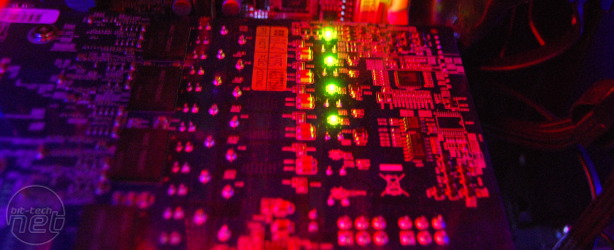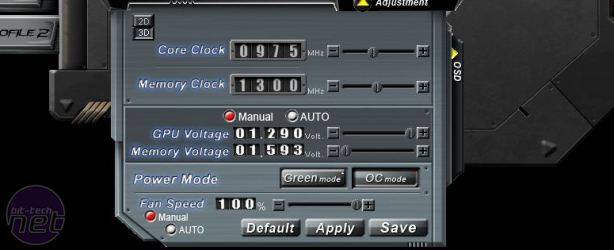Gigabyte Radeon HD 5870 SOC Graphics Card Review
July 1, 2010 | 11:25

Performance Analysis
When it comes to pre-overclocked graphics cards, we can be fairly sure that the performance analysis will go along the lines of ‘it’s a bit faster than the standard card.’ However, the Gigabyte SOC is heavily overclocked, so the question we wanted to answer was whether it could match a GeForce GTX 480. Dirt 2 is a mixed bag for the two graphics companies, with ATI weak at 1,680 x 1,050 but much stronger at higher resolutions. At 2,560 x 1,600 with 4x AA the Gigabyte SOC was 2fps faster than a stock-speed Radeon HD 5870, meaning that it was just 3fps slower than a GTX 480 with its minimum of 43fps.STALKER: Call of Pripyat favours the design of ATI’s current hardware, and while the Gigabyte SOC was only 1-2fps faster at 2,560 x 1,600, that still meant that it had a comfortable 6-9fps lead over the GTX 480. The minimum frame rate of 36fps was smooth and eminently playable, unlike the frame rates we saw from Crysis at anything beyond 1,680 x 1,050.

Apologies for the garish test rig (we blame the long exposure) but we wanted to show the LEDs on the back that show the power load of the card. Click to enlarge
When not using AA the Gigabyte SOC was 2-3fps faster than the GTX 480, but the GTX 480 was king when we used AA by the same kind of margin. Neither card could play the game smoothly at 1,680 x 1,050 with 4x AA though, so the Gigabyte SOC just about edges ahead of the GTX 480 for everyday use. If you are trying to choose a card for a Crysis benchmarking competition, you’ll probably be better off with the GTX 480, as it’s a reasonable match for the Gigabyte SOC even at stock speeds.
If anyone ever holds a Bad Company 2 tournament, you’ll definitely want the GTX 480, as the Gigabyte SOC didn’t topple the card from its top spot, except at 1,680 x 1,050 with no AA. In fact, depending on whether we used AA or not, the Gigabyte SOC mainly traded blows with the GeForce GTX 470 in this game. At 1,920 x 1,200 with no AA both the Gigabyte SOC and the GTX 470 managed a minimum frame rate of 49fps but the Gigabyte SOC had the superior average frame rate of 81fps rather than 67fps. However, applying 4x AA saw the game drop to a minimum of 34fps on the Gigabyte SOC but only 37fps on the GTX 470.
The cooler of the Gigabyte SOC worked well when it came to temperatures, keeping the GPU to a delta T of 15°C at idle and to 39°C when under load. However, the fan was on the noisy side, even if the noise was a low-pitch thrum and didn’t increase too noticeably when the card was working hard. As expected, the Gigabyte SOC consumed more power than a standard HD 5870 – it was 19W more thirsty when idle and 28W more when under load.
We had some joy when overclocking the Gigabyte SOC using Gigabyte’s bundled (and weird-looking) OC Guru software. Not content with including advanced overclocking functions such as GPU and memory voltage sliders, the software can apply an Eco mode and track how much power you’re saving by doing so. By applying a GPU voltage of 1.299V (the maximum on offer) but keeping the memory at 1.593V we managed to boost the GPU from 950MHz to 975MHz and the memory from 1.25GHz (5GHz effective) to 1.3GHz (5.2GHz effective). This saw an increase of 1fps in Crysis, which was well worth the effort. Not.
Conclusion
The only 1GHz GPU we’ve seen is the Sapphire Radeon HD 4890 1GB Atomic, and even that has been withdrawn as there wasn’t a sufficient supply of fast enough GPUs that Sapphire could use. We had hoped that the Gigabyte SOC would become the second 1GHz GPU to grace our labs, but alas even the stout power hardware, chunky cooler and overvolting tool of the Gigabyte HD 5870 SOC weren’t enough to deliver. Gigabyte has shipped the card with a large overclock though – other HD 5870 GPUs struggle to hit 950MHz even after we’ve had a crack at them with AMD GPU Clock Tool and a couple of case fans.Unfortunately, the consequence of all this is a card that’s only a few frames per second faster than a standard HD 5870, and yet costs over £100 more. Clearly for the average gamer, it’s not a great purchase. That might be missing the point, as all the overclocking-friendly hardware could make this card an option for competitive overclockers (at least, those that don’t have sugar-daddy sponsors). However, our overclocking session didn’t reap brilliant rewards over and above what we already had – just a 25MHz (2.6 per cent) increase in the GPU speed – despite us using the maximum voltage available and still not hitting a thermal limit. As a piece of engineering, the Gigabyte SOC is a solid effort, but as a card to buy and live with it’s not worth getting.
- Performance
- x
- x
- x
- x
- x
- x
- x
- x
- x
- -
- 9/10
- Features
- x
- x
- x
- x
- x
- x
- x
- x
- x
- -
- 9/10
- Value
- x
- x
- x
- x
- -
- -
- -
- -
- -
- -
- 4/10
- Overall
- x
- x
- x
- x
- x
- x
- -
- -
- -
- -
- 6/10

MSI MPG Velox 100R Chassis Review
October 14 2021 | 15:04









Want to comment? Please log in.